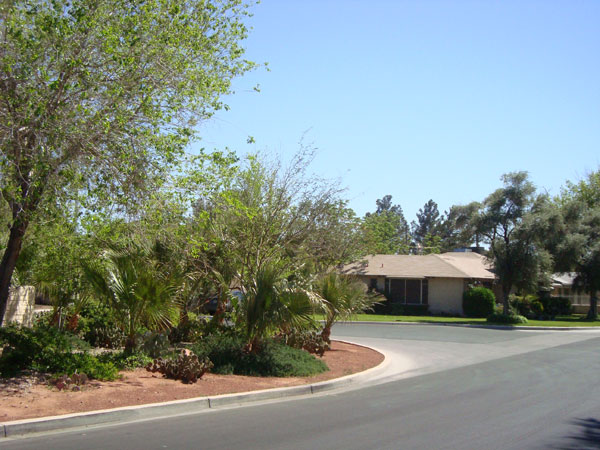April 23, 2010
American Planning Association
Attn: Richard Lukas, Senior Outreach Associate
1776 Massachusetts Avenue, NW-Auite 400
Washington, DC 20036
Dear Mr Lukas,
I write today to express my enthusiastic support for the John S. Park Neighborhood's consideration by the APA to be listed among the association's Great Neighborhoods.
Centrally located in the heart of the city of Las Vega, it's unique and historic architecture provides a snapshot in time to the early and mid-century community which was evolving from a railroad water stop, and is now surrounded by a skyline of resorts unparalleled in commerce and awe. Yet through nurturing, and persistence, this neighborhood has seen a renaissance of pride. The only thing greater than the John S. Park housing architecture, is the residents who call it home; an eclectic mix of old-timers, with deep roots, and the new faces of youth, families, artists, professionals, and generally, people of passion.
As a nine year member of the City of Las Vegas Planning Commission, it was my honor to have been the Commissioner to make the motion to designate the John S. Park Neighborhood as an historic neighborhood. Whether the story is about the Rat Pack, and Frank and Dino at a neighborhood party, or the remembrances of long-ago farms and artisan springs - the designation as historic is unchallenged.
I wholeheartedly endorse John S Park as a Great American Neighborhood.
Sincerely,
Steven Evans
1705 Cochran Street
Las Vegas, NV 89104

John S. Park Neighborhood
Designated location
The neighborhood is bounded by Las Vegas Boulevard, a National Scenic Byway, to the west; South Ninth Street to the east; Charleston Boulevard to the north; and Franklin Boulevard to the south.
Summary
Home to some of Las Vegas's most distinguished residential architecture, the 120-acre John S. Park neighborhood offers an old-fashioned, down-home feeling of tranquility within a half-mile of the glitz and glamour of the city's adjacent and world renowned Strip.
A source of local pride, the neighborhood's serene and charming character has been fiercely guarded over the years. Responding to the threat of commercial encroachment in the mid-1990s, residents rallied by creating a neighborhood plan and acquiring local and national historic designation for two of its subdivisions. The effort succeeded and held casino and resort developers at bay.
Las Vegas, Nevada
Although not the city's oldest neighborhood, this was the first in Las Vegas to embrace the 19th century Garden City planning philosophy. Originating in England, garden cities feature park-like, secluded settings and tree-lined, curvilinear streets. Developed primarily between 1931 and 1956 for those who created the "Entertainment Capital of the World," the neighborhood contains architecture ranging from Period Revival to post-World War II ranch.
Increasingly diverse, today more than 1,000 people live in mostly single-family houses and duplexes. The neighborhood is within easy walking distance of the city's downtown government and core casino business district, and residents have convenient access to basic goods and services as well as to mass transit service. A restored pocket park serves as the neighborhood's gateway, easing the transition between homes and surrounding commercial areas.
Defining Characteristics, Features
Historic Nature
- John S. Park Historic District is the only Las Vegas historic district to be designated both locally (2003) and nationally (2003)
- District includes two adjacent subdivisions. Development of Park Place Addition (1931-1952) coincided with demand for housing associated with Hoover Dam construction. Vega Verde Addition (1941-1956) corresponded to demand for housing connected with establishing Nellis Air Force Base
- Historic district has 160 houses, 34 of which are non-contributing; some houses modified but neighborhood retains original look
- Oldest homes reflect popular Colonial-Revival architecture; later ones have a Minimal Traditional or ranch-style look. District contains several of the last remaining Tudor-style houses in southern Nevada
- Historic Preservation Commission reviews building permit applications for proposed work that will impact a designated historic resource
- Design guidelines (2006) define seven district characteristics and methods of preservation; illustrate typical architectural characteristics of historic housing styles
Embraces Planning
- First Las Vegas neighborhood to adopt vision espoused by 19th century English Garden City planners; street layout does not follow existing grid; curvilinear streets have limited access from the busy commercial streets bounding neighborhood.
- First complete planned subdivision in city approved by FHA for loans to homeowners
- Neighborhood plan (2001), developed by neighborhood association under guidance of city's Neighborhood Services Department, outlines five areas of concern and strategies; paves way for historic district designations, preservation of community character
- $1.47 million restoration of Mary Dutton Park (2003) establishes neighborhood gateway; 14-foot stainless steel sculpture of plow and water created by neighborhood resident to show how Mary Dutton farmed land in the 1920s
Engaged Residents
- Neighbors formed John S. Park Neighborhood Association (1995) to protect unique area; today one of city's most powerful and influential voluntary groups
- City adopted neighborhood planning process (1998); city planners helped neighborhood association develop plan (2001); application for local and national historic designation (2003) was a resident-driven effort
- Residents successfully blocked Titanic-themed casino and resort, Stratosphere casino and resort roller-coaster, and expansion of a major adult-themed business
- Most advanced and well-developed block watch in Las Vegas; neighborhood holds annual clean-ups, biannual block parties
Sustainable Neighborhood
- Compact and easy to navigate by foot, neighborhood is adjacent to emerging arts district and a commercial district offering shopping, ethnic restaurants
- Mass transit service to all areas of the valley via Las Vegas and Charleston Boulevards
- Tree canopy coverage is 34 percent — 23 percent higher than city average. More than 20 residents in this mid-century, large-lot neighborhood of conventional landscaping invested more than $65,000 to convert lawn turf to xeriscape landscaping. Las Vegas adopts Urban Forestry Initiative (2008) to increase tree canopy citywide
